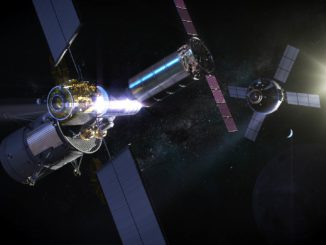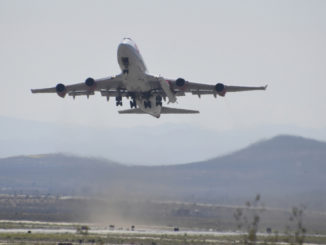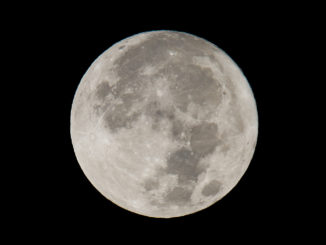
While NASA and Boeing engineers investigate the cause of a software error that cut short the first orbital test flight of the Starliner crew capsule last month, ground teams have returned the spaceship from its landing site in New Mexico back to the Kennedy Space Center in Florida.
Preliminary inspections indicate the reusable spacecraft weathered its first trip into orbit better than expected, and Boeing teams are confident the ship will need only “minimal refurbishment” before its next launch with astronauts.
While teams sort out the Starliner software problem, Boeing says the hardware performed as designed.
“It’s in really good shape, very little external wear on the outside,” said Tim Reith, spacecraft engineering manager for Boeing’s Starliner program.
“The team built an awesome vehicle,” said Ramon Sanchez, senior operations lead for Boeing’s commercial crew program.
“For the most part, the vehicle performed very well, and we’re looking at minimal refurbishment to return this thing to flight,” Sanchez told reporters Wednesday during a media briefing inside Boeing’s Commercial Crew and Cargo Processing Facility at NASA’s Kennedy Space Center in Florida.
The capsule landed Dec. 22 at White Sands Space Harbor in New Mexico, descending under parachutes before deploying airbags to cushion its touchdown in the remote desert. The unpiloted Orbital Test Flight lifted off Dec. 20 aboard a United Launch Alliance Atlas 5 rocket from Cape Canaveral, but a timing error in the Starliner’s software that went undiscovered before launch caused the spacecraft to miss a planned orbital insertion burn.

The insertion burn was planned a few minutes after the Atlas 5’s Centaur upper stage deployed the Starliner spacecraft on a trajectory with a velocity just shy of that needed to enter a stable orbit. The Atlas 5 put the Starliner where it needed to be, and the Boeing capsule’s orbital maneuvering rockets were supposed to ignite to boost the spaceship into a preliminary orbit to begin its pursuit of the space station.
But an on-board mission elapsed timer had a wrong setting, causing the Starliner spacecraft’s computers to believe the capsule was operating in a different phase of its mission. The capsule’s service module began firing maneuvering thrusters to control the vehicle’s pointing, consuming much of the craft’s fuel and causing it to miss the automated orbit insertion burn.
The spacecraft was trying to perform two functions at the same time time, Reith said.
“That’s where the vehicle got a little confused,” he said. “The orbit insertion, which the vehicle thought had already happened in the past, it was trying to prepare for that, as well as do some pointing guidance, and those two events were kind of in conflict with each other.
“That’s were we had the vehicle kind of fighting itself, if you will, and the thruster firings going,” Reith said. “You’ve got multiple software sequences running, so that’s where it got confused with multiple things going on at the same time.
Ground controllers noticed the problem and tried to intervene, but commands to override the Starliner’s automation did not reach the spacecraft in time to perform the planned orbit insertion burn and keep the mission on track to dock with the International Space Station.
“Everything’s automated, so the vehicle should have started moving itself toward this orbit insertion burn,” Reith said. “When that wasn’t happening, the flight control team in Houston and the engineering support teams around the country, we were able to figure that out pretty quick.
“It was very intense,” said Reith, who also served as spacecraft chief engineer in the Starliner mission support room during last month’s mission. “You also have to remember this was the first time we’d seen it fly, so you have an expectation of what should happen, but at the same time you’re not sure what it’s going to do. So as you’re seeing things for the first time, you’re trying to understand is that what it should be doing, or is there something anomalous going on?”
“Essentially, there are two opportunities for us to prepare for that orbit insertion burn,” he said. “When the first opportunity missed, and at the same time we were watching the telemetry from the vehicle with a lot of thruster firings, you start realizing, OK, something’s not right. So the flight control team attempted to send commands, and the vehicle wasn’t in a really good orientation from an antenna standpoint to receive those commands. So it kind of went on for a while until we got the antennas where we could get a good command to the vehicle. Once we got that command uplinked, we were able to turn the vehicle and do that orbit insertion burn that at least raised it up a little bit. But by that time we had expended a lot of propellant.”
Instead of performing the pre-programmed insertion burn, the Starliner fired its engines to reach a stable orbit that ensured the capsule could safely return to Earth. By that time, the capsule had consumed too much propellant to complete the required burns to pursue the space station and perform a docking.
“We had full control of the vehicle,” Reith said. “It didn’t tumble or anything like that.”
The original eight-day flight plan, which included demonstration maneuvers and a docking with the space station, was shortened to two days. The capsule successfully landed in New Mexico, achieving many — but not all — of the planned objectives of Boeing’s Orbital Flight Test.
The demonstration mission was a precursor to the first planned Starliner mission with astronauts — known as the Crew Flight Test — scheduled to launch later this year.

Boeing technicians are assembling a separate Starliner spacecraft for the Crew Flight Test. Located in an integration cell just a stone’s throw away from the Starliner that just returned from space, the CFT capsule will carry Boeing astronaut Chris Ferguson and NASA crewmates Mike Fincke and Nicole Mann to the space station.
Boeing has produced two reusable human-rated spaceships — each designed for 10 missions — for flights to the space station under a $4.2 billion contract with NASA. The space agency has signed a similar $2.6 billion contract with SpaceX in 2014 for development of the Crew Dragon spacecraft, on which astronauts will fly new vehicles on each mission.
The CFT mission with Ferguson’s crew will pave the way for operational crew rotation flights to the station, the first of which will be commanded by NASA astronaut Suni Williams, a veteran of two long-duration space station expeditions. Williams is slated to launch and land on the same capsule that flew on last month’s two-day demonstration mission.
She named the spacecraft “Calypso” after its Dec. 22 landing in honor of the research vessel used by French explorer Jacques Cousteau.
The planned Starliner flight sequence hinges on the outcome of an investigation into the cause of the software error that prevented the Calypso spacecraft from docking with the space station last month.
“The independent team will inform NASA and Boeing on the root cause of the mission elapsed timer anomaly and any other software issues and provide corrective actions needed before flying crew to the International Space Station for the agency’s Commercial Crew Program,” wrote NASA Administrator Jim Bridenstine on the space agency’s website Jan. 7.
The investigation is expected to last about two months, according to Bridenstine.
The NASA boss said agency officials are evaluating data from the Starliner’s Orbital Flight Test to determine if another unpiloted demonstration flight is required before the capsule is cleared to launch with astronauts. A decision on that matter is not expected for several weeks, Bridenstine wrote.
“Although docking was planned, it may not have to be accomplished prior to the crew demonstration,” he wrote. “Boeing would need NASA’s approval to proceed with a flight test with astronauts on-board.”

After the Starliner’s landing Dec. 22, Boeing teams secured the spacecraft and transported it via truck from New Mexico back to the Kennedy Space Center, where it arrived Jan. 8.
“Currently, it’s under assessment by … many of our experts,” Sanchez said Wednesday. “We have got the hatch door open. We will take an assessment of the exterior of the vehicle.
“We have to make sure the interior is flight-ready,” Sanchez said. “It’s an awesome vehicle, well-built with safety and quality in mind.”
The Starliner spacecraft includes two segments — a crew module and a service module — for the trip to the International Space Station. After departing the station and performing a braking burn to re-enter the atmosphere, the crew module jettisons the service module to burn up over the Pacific Ocean.
The crew module is fitted with an ablative base heat shield, thermal tiles, and protective blankets to withstand the scorching temperatures as hot as 3,000 degrees Fahrenheit (1,650 degrees Celsius) during re-entry. The capsule jettisons a forward heat shield at the start of its parachute deployment sequence, then releases the base heat shield to plunge to the ground, allowing airbags to inflate to soften the crew module’s landing.
That means each Starliner mission will fly with a new service module, and new forward and base heat shield elements. Teams will also have to re-pack parachutes and replace the mortars that fire to unfurl the chutes during descent, and an ascent fairing that covers the Starliner docking module will also come new with each mission, according to Sanchez.
According to Reith, a manager on the Starliner engineering team, the reusable thermal blankets on the “backshell” panels around the circumference of the Starliner spacecraft showed little sign of damage from the re-entry.
“You can see on the front — the hot side or leading edge side of the vehicle where the tiles are — you see a little deposit there,” Reith said. “We’ll go through and clean that up,” Reith said. “That should come right off.
“There’s a dark diagonal stripe up the vehicle,” Reith told reporters Wednesday. “There’s a matching one on the other side. That’s where the plasma flow is. It comes around the vehicle … So as it was picking up ablation off the base heat shield, it streaked up there and left that deposit.
“We’ve got high expectation that’s going to come right off, so we’ll be able to clean this vehicle up and get it to near factory-fresh (condition) again for its next mission” Reith said.
“Right now, the team is doing their external inspections,” Reith said. “We’ve had teams in looking at the top where the NASA docking system is. They’ve done all their inspections looking at that, and also the thermal protection system team, they’ve been looking at the blankets, the tiles we have.
“Once they’re done with their work, we’ll go ahead and take the backshell panels off,” he said. “These are the gray panels that enclose all of the equipment inside … Then we’ll start doing our inspections on the inside. At the same time we’ll be starting to take the cargo (that was to be delivered to the space station) off, Rosie will come off, and then we’ll start our refurbishment of the inside of the vehicle getting ready for the next mission.”
Reith said Boeing teams will also remove the airbags from the bottom of the crew module to check for damage. The airbags are also designed to be reused on future flights.
“It looks really clean from a standpoint of the wear-and-tear it took coming through re-entry,” Reith said. “Our TPS (thermal protection system) team is really, really surprised. They expected more blanket wear, more deposits. They’re really happy with the way the vehicle performed.”
Email the author.
Follow Stephen Clark on Twitter: @StephenClark1.



